Field crop problems ranging from stunted or abnormal plants to dead or dying plants can pose urgent and difficult questions with economic consequences for producers. A systematic approach to help farmers and crop consultants determine the cause(s) of these problems helps prevent the bias of looking only for familiar issues.
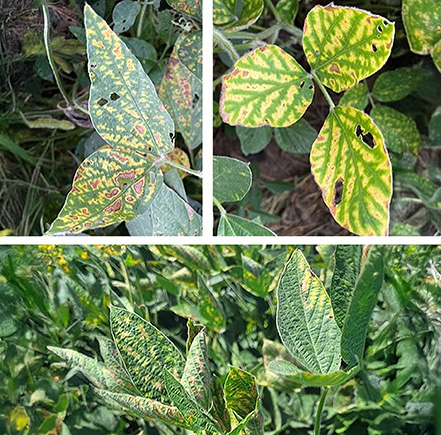
1. Determine the variety and age of the plant
Identify the plant variety and age to provide a basis for defining its normal appearance. This information may come from personal knowledge of the plant and its characteristics, consultation with experts, or published references. Many plants may appear abnormal to someone unfamiliar with the crop and variety. In addition, the variety is important to note, because some varieties are more resistant or susceptible to certain diseases, insects or herbicides.
2. Identify all symptoms affecting the leaves, stems, roots and fruit
Examine all parts of abnormal plants, including the leaves, stems, fruit and roots as well as the tissue inside roots and stems. Some issues may cause similar symptoms on the leaves but affect other parts of the plant differently. For example, in soybean, interveinal chlorosis (yellowing) of leaves can have multiple causes, such as sudden death syndrome, red crown rot, brown stem rot, or fungicide injury (Figure 1). Assessing the stems and roots is essential for accurately identifying the cause or causes of interveinal chlorosis.
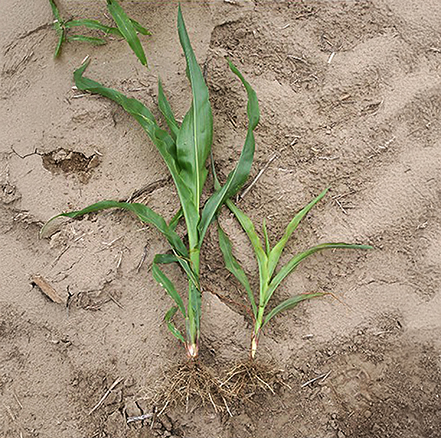
Frequently, the point of injury to the plant is not where the symptoms appear. For example, symptoms of herbicide carryover injury to roots may first be observed in the aboveground growth (Figure 2).
When examining individual plants, consider the following observations:
- Are symptoms present on old or young leaves?
- Are symptoms confined to one side of the plant?
- Are insects visible or is there evidence of insect feeding?
- Is there discoloration or deterioration of the stem when split open? (Figure 3)
- Are there abnormalities in color, size, shape, or texture of leaves?
- When leaves are held up to sunlight is there evidence of webbing and mites or mosaic patterns indicative of viral infections?
- Are roots stunted or discolored?
- What is the condition of the secondary or feeder roots?
- Is there evidence of galls or root rot?
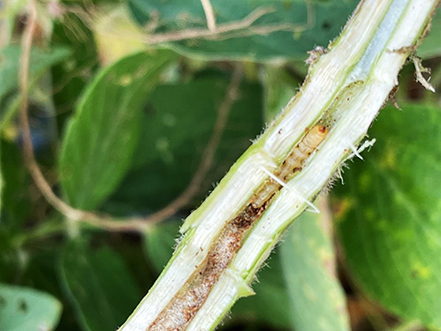
Additionally, when carefully digging up the roots, note the properties of the soil, including texture, organic matter content, the presence and depth of hardpans, planting depth and fertilizer placement. Check for signs of soil compaction and note unusual odors.
3. Determine the field distribution or pattern of the problem in the field
Inspect the field systematically: start at the front, cross diagonally, and traverse the back before returning to the starting point. Follow this pattern flexibly enough to permit inspection of unusual areas of a field. The ends of rows and turn rows are especially interesting and should always be carefully examined. Excesses of agricultural chemicals and fertilizers at row ends due to improper speed of application equipment can result in crop injury. Also inspect plants in fence rows and the crops in surrounding fields and determine what agricultural chemicals have recently been used in these fields.
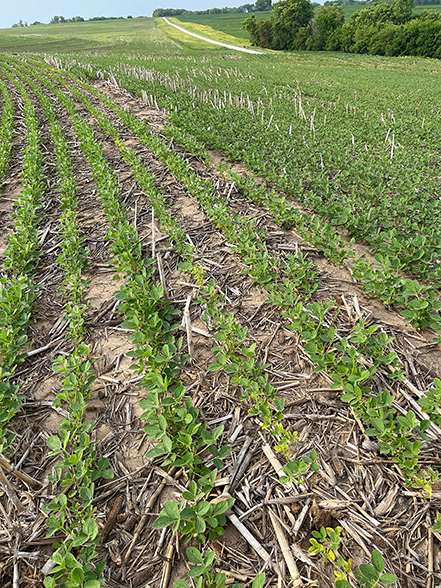
Analyze the distribution of the problem in the field as it relates to field characteristics and drainage patterns. Take notice of whether the problem is associated with certain rows or areas of lower or higher elevation. Crop problems due to insects may develop because of a plugged insecticide applicator on a planter. Crop problems may also be caused by soil texture changes in a field, soil compaction because of traffic, overlap of a spray boom (Figure 4) or mixed nozzle sizes on a spray boom, and spray drift from a nearby field.
The distribution of affected plants can provide valuable insights into the probable cause of the problem. For example, diseases caused by pathogens that live in the soil have a strong interaction with soil characteristics. Typically, these diseases are distributed in large, circular to irregular areas that may reflect soil type, drainage patterns, cropping history, herbicide use or topographic features.
Symptoms of nutritional deficiencies and herbicide injury generally appear all at one time, and usually the injury does not continue to spread either throughout the individual plant or onto unaffected plants. Often there is a clear demarcation between injured and healthy tissue on the plant. Depending on the causal agent, damage may be widespread and include different crops.
4. Estimate the percentage of plants damaged in the affected part of the field and the severity of damage
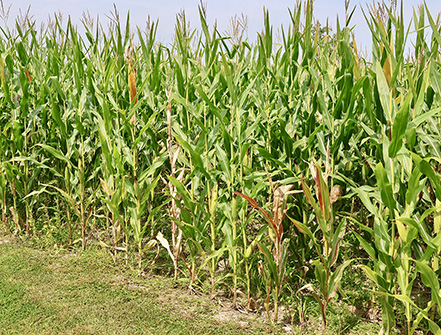
Do you observe damage on all plants in the affected area or only a percentage of them? Symptoms of injury due to insects and disease may appear on every plant in an infected area, but not always (Figure 5). Symptoms of injury due to herbicides usually appear on every plant in an area.
5. Evaluate whether other plant species (weeds) in the field share similar symptoms
Examine the weeds in the area where the crop is injured and in nearby fence rows. For example, diseases are usually host specific, and weeds in the area are normally not affected. Leaf spots caused by drifting droplets of a contact herbicide (for example, paraquat) are not host specific, and several plant species in the area may show similar leaf spotting. Symptoms caused by nutritional disorders are usually not host specific. For example, low-pH soils will cause stunting of most plants in the field, including crops as well as weeds (Figure 6).
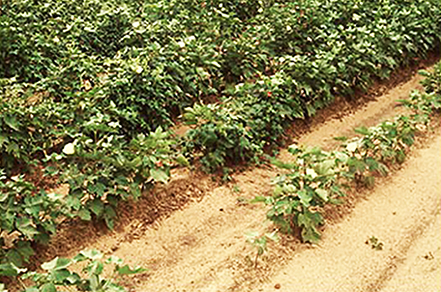
6. Determine the history of the problem
Ask when the problem was first noticed and whether crop problems were observed in the same area during previous growing seasons. Other important points include the following:
- Dates and rates of fertilizer application, pesticide and growth regulator applications, seed treatments, and any deviations from the typical crop management programs.
- Crop rotation and the presence/absence of a winter cover crop.
- Irrigation frequency, rate, timing and water quality.
- Soil pH, soil texture and drainage, planting depth, cultivation, cropping history, earth moving or construction, and burial or disposal on the site.
- Air temperature, humidity, wind, lightning, clouds and air quality before and during symptom development.
- Rate of symptom development coincident with any treatment or environmental event.
- Recent human, animal, insect or mite activity around or on symptomatic plants.
- Herbicides and rates used the previous year.
- How the disease is progressing and whether symptoms are becoming better or worse with time.
Needed equipment
The following items are useful when diagnosing field crop problems:
- Trowel or shovel
- Plastic bags for plant samples
- Knife
- Notepad and pencil or pen
- Magnifying lens (five to 15 times magnification)
- Camera
- Ice chest
- Sweep net
- Vials
- Field manuals
Troubleshooting a crop problem
As an example of how to resolve a somewhat complex plant problem, consider a soybean field in which all the plants in one corner exhibit tip dieback and marginal leaf scorch. The affected plants appear to have developed the syndrome at about the same time. A review of the grower’s management practices indicates there had been a fertilizer application a week before symptoms developed. The environmental conditions after the application included a small amount of rainfall followed by dry, sunny weather.
The affected corner of the field is characterized by higher elevation and a drier soil type than the rest of the field. A predisposing factor is the soybean variety’s sensitivity to soluble salts (fertilizer).
You determine that the problem is due to fertilizer burn from excess soluble salts in the soil. You reach this conclusion by assembling in a systematic way the following pieces of information:
- Pattern of injury on individual plants
Tip dieback and marginal scorch - Pattern in crop
One field corner only - Time frame for symptom development
All at one time - Management practice
Fertilization - Environmental events
Slight rain followed by dry weather - Soil factors
Drier soil in one area of the field - Predisposing plant factors
Salt sensitivity of soybean variety
The grower could confirm this presumptive diagnosis with a soil test for total soluble salts by submitting the soil sample to Soil and Plant Testing Laboratory. Meanwhile, if a plant disease problem is suspected, the plant sample can be submitted to Plant Diagnostic Clinic.
Checklist
Print the systematic checklist for diagnosing Missouri row crop problems (PDF) to assist your evaluation.